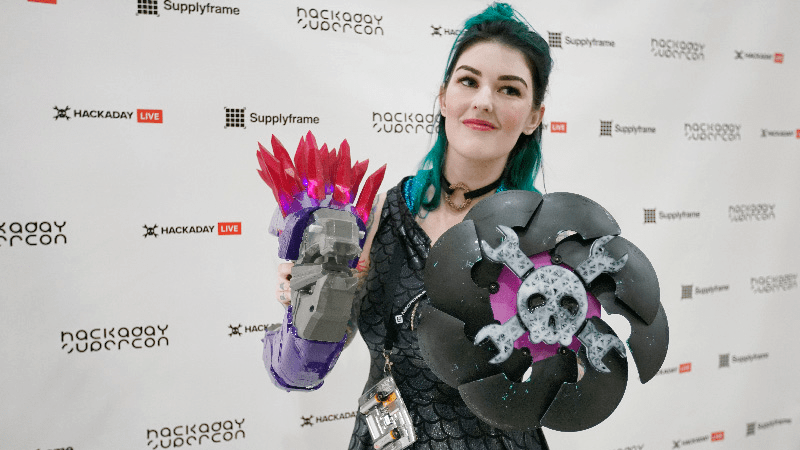For her day job, Amie D Dansby works as a software simulation developer, creating simulations for video games. In her free time, she’s implanting the key to her Tesla in her arm, building cordwood jewelry and cosplay swords, and seeking out other adventures in electronics and 3D printing. Amie has made a name for herself in the 3D printing community, and she is surrounded by fans when she attends the RepRap meetups and Maker Faires.
She was also popular at this year’s Hackaday Superconference, where she gave a talk on the integration of 3D printing and electronics. Amie’s work concentrates on props and cosplay, which is a skill unto itself, and you only need to look at some of the old Mythbusters, the documentary footage from ILM, or even model makers to realize this is an arcane art that takes a lot of skill. Lucky for us, Amie was there to show us the tricks she’s picked up over the years to make building a one-off piece easier than you could imagine.
If you’re doing something as a job or a hobby, you eventually come up with a bag of tricks, tools of the trade, or other shortcuts to make building the next thing easier. Electronic props are no exception. If you need a circuit that blinks some LEDs and makes noise with a speaker, you’ll probably design something once and reuse it over many projects. [Amie] is doing just this, with a technique she’s calling a ‘black box’. These black boxes could be servos connected to a microcontroller, or just a battery, light, and switch. Either way, the more you do something the better you get at doing it, and making hardware is no exception.
But for Amie, most of her insights into creating custom props and cosplay equipment are in the field of library management. Amie uses Fusion for a lot of her work, and you can get Fusion models for almost the entire McMaster Carr catalog. Having this bible of mechanical engineering at your fingertips as a 3D model is a force multiplier; not only can you model something, you can also buy the part you need. The McMaster Carr catalog is truly one of the great heros of engineering, and whoever decided to put those 3D models into Fusion deserves sainthood.
More than that, Amie is using library.io, Autodesk’s ‘datasheet to Eagle part’ tool. This is also a game changer. You’ll never have to make a part in Eagle again, and it’ll generate a CAD model too. Amie is also designing parts using parametric tools, a great technique that enables remixing of designs.
As for what she’s built, you’ve got Farscape guns and LED couture. You’ve got swords from Zelda, and stuff with gears. Amie is one of the more productive and creative talents out there, and we were more than happy to hear about how she works at the Hackaday Superconference.
















“For her day job, Amie D Dansby works as a software simulation developer, creating simulations for video games. ”
Sounds interesting too.
Aimie is AWESOME.!. Fun. Funny. Informative. Useful info.
Where am I? What is this? What’s going on? This is HAD I think. Brian Benchoff wrote/Linked this? Aimie is an AI Android experiment that escaped from a think tank somewhere and HAD somehow got ahold of her. That has to be it. Run Aime. Snicker. Tks.
What he said^^.
I’ve stopped reading hackaday because of articles like this. There is hardly any info in the text other than Aimie is awesome, and i still know nothing about the “3D printing for electronics” which is mentioned in the headline
“I’ve stopped reading hackaday”
But continued commenting?
I assure you, this is the case for the majority of commenters.
Heh, heh—so true!
You’re a better person than I if you can figure out WTF OP is talking about, much less agree with it.
I wrote Aimie is awesome not Brian. The info is in the video and mentioned in article . Please do watch the video. There is some good info in there and it Actually matches article title. Biggest mention therein would be the Huge collection of 3D models available of real world items that can be incorporated into your models. Not limited to electronics parts. Many starters arent aware of McMaster-Carr which in itslef is a good resource but also 3D models resource. One of Aimie’s examples was a switch. Dont grab the mic and and sit there measuring it off. Go over to Huge collection. Find the switch you need. Download to whichever 3D editor(CAD) your using. Fit or forget as needed.
Works in games… has free time.
Um… these things are mutually exclusive. If you work in games, you are in the office 80 hours a week… there is no time or brain left for anything else.
This is usually true, the game dev industry is a really horrible culture with zero security and zero work-life balance for most people. That happens when hiring is basically a tournament structure and at any given moment there’s ten thousand independently wealthy kids scrambling over themselves for your position. You don’t really get to bargain for any benefits in a situation like that.
Maybe that’s why they want to unionize?
https://www.engadget.com/2019/01/24/nearly-half-of-game-developers-want-to-unionize/
Best advice of the talk: When asking someone about their project the best question is -> “What didn’t work?” . Great stuff.